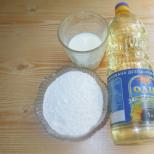Easter yeast bun recipe. Easter buns "Larks"
In addition to the usual Easter cakes, you can cook very tasty soft, tender and ruddy Easter buns with raisins, decorated with a pattern of white dough. In our family, such pastries are called "Christ's Buns", probably because I put a pattern in the form of a cross in the middle of each bun. You can learn how to cook such simple and delicious yeast cross buns for Easter from my step-by-step photo recipe.
For the main test:
- cream margarine - 100 gr;
- milk - 0.25 l;
- egg yolks - 2 pcs.;
- table salt - ½ tsp;
- dry yeast - 20 gr;
- flour - 550 gr;
- granulated sugar - 100 gr;
- raisins -80 gr.
Pattern dough:

- milk - 60 ml;
- sunflower oil - 1 tsp;
- flour - 60 gr.
For glaze:

- powdered sugar - 30 gr;
- milk - 50 ml.
How to make sweet dough for buns
Pour the heated milk into a bowl, dissolve the yeast and a tablespoon of sugar in it. In order for the dough to rise, you need to create “comfortable” conditions for it, that is, put it in a warm place for about twenty minutes.

In the meantime, we need to melt the margarine and dissolve the granulated sugar in the hot margarine.

In the margarine-sugar mixture placed in the mixer, we introduce and beat the yolks.

Pour raisins, previously sorted from garbage, with boiling water for ten minutes.

Then, drain the water, and dry the raisins on a paper towel.

Before adding to the dough, mix the raisins with a small amount of flour.

We always sift the flour before baking.

Opara has risen, and we can proceed to the actual kneading of the dough. Add a mixture of eggs, sugar and margarine to the dough. Then, little by little, we begin to stir in the flour.


The elastic and pliable bun of dough obtained as a result of kneading is removed in heat to rise for half an hour.

How to make buns for Easter
After a while, we knead the dough a little with our hands and tear off small pieces from it, from which we form round buns.

We put the buns on a baking sheet covered with parchment paper so that they do not touch each other.

Next, we need the buns to rise. To do this, put the baking sheet in a preheated oven on the smallest fire, while the oven door should be ajar. In about twenty minutes, the buns should increase in size.
How to decorate buns for Easter
While the pastries are resting, we need to prepare the dough for applying the Easter pattern. Mix milk, vegetable oil and flour.

The result is a slightly watery white dough.

The buns have risen and with the help of a culinary syringe or apply a pattern in the form of a cross on them.

How to bake Easter Buns
We will bake the buns in the oven over medium heat for twenty minutes.
While our delicious Easter cakes are baking, prepare the sweet glaze. To do this, simply dissolve the powdered sugar in milk.

We apply icing on ready, still hot, raisin buns with a culinary brush, and send the baking sheet for another five minutes in a hot, but already turned off oven.

As a result of our efforts, we got the most delicious, beautiful, shiny and ruddy, very fragrant yeast cross buns for Easter.

And here is what the cake looks like. Even in the photo you can see that the structure is porous and airy.

In addition to the freshest yet hot and very tender Easter bun, you can offer your eaters a cup of village milk.

Having a step-by-step recipe with a photo at hand, you can easily bake simple and beautiful Easter buns for your family.
Easter is coming soon. I propose to bake yeast decorative buns in the form of Easter bunnies and birds for the festive table. I think that such pastries will be appreciated not only by adults, but also by small children. After all, it is not only unusual, but also very beautiful and tasty. Easter buns will perfectly complement and diversify the festive Easter table.
Warm milk slightly. The temperature of milk should be approximately 36-37 degrees. If yeast is poured into too hot milk, then we will brew it and our yeast will not come to life. Pour yeast into milk, add sugar and mix. Leave the yeast mixture for 15-20 minutes in a warm place for the yeast to revive. I cover the container with yeast with cling film. Melt butter and cool slightly.
A fluffy, bubble cap should appear on the surface of the milk. If the cap does not appear, then the yeast has not come to life and you cannot use such a mixture.

Pour the risen yeast and butter into a deep bowl. Then beat in the egg and add salt. Mix everything well.

Next, add the sifted flour in small portions and knead a soft and tender dough. The dough will be slightly sticky to your hands. The bowl in which we leave the dough must be greased with vegetable oil. Put the dough in a bowl, cover the bowl with a towel and put in a warm place for 1-1.5 hours.

The dough will double in volume. Knead the risen dough well and leave it in a bowl for another 30-40 minutes to rise again.

Put the finished dough on the surface of a silicone mat or on a table powdered with flour. Knead the dough lightly and then divide it into 10-12 pieces. I make small Easter buns.

Before forming the buns, it is better to grease your hands with vegetable oil so that the dough does not stick to your hands. In order to form a bird from the dough, you need to roll the sausage out of the dough, and then wrap it in a knot. One part of the dough will be the head, and the other part will be the tail.

The tail part must be cut with a knife or scissors into 3-4 strips. On the head, slightly stretch the dough and form a beak.

Then, when we have formed the head and tail, we need to "feather" our bird. To do this, use scissors to make small cuts in the area of \u200b\u200bthe wings (lubricate the blade of the scissors with vegetable oil). Cut small pieces of prunes and paste them into the eye area. You can use dark raisins instead of prunes.

Grease a baking tray with vegetable oil. Put the resulting birds on a baking sheet and leave them for 20 minutes in a warm place, without drafts. Then brush the buns with beaten yolk. Preheat the oven to 180 degrees. Put the baking sheet with the buns in the oven. Bake the buns for about 20-25 minutes until golden brown.

To form a bunny, divide the dough into three parts: large, medium and small. Make a body from a large part of the dough: form a long sausage from the dough and roll it into a snail. Make a head from the middle part of the dough: form a small oval from the dough and cut it into half - you get ears. Make an eye out of a piece of prunes or raisins. And from the smallest part of the dough, make a tail: roll the dough into a small ball.
In the photo, I showed how I use and form a bunny from dough. I make up all the parts of the bun on a baking sheet. You need to tightly attach the head and tail to the body. And when the dough comes up, and we grease it with yolk, our bunny will completely hold together.

Grease a baking tray with vegetable oil. Put on neo the resulting bunnies. Leave the baking sheet with the buns for 20 minutes in a warm place. Preheat the oven to 180 degrees. Then brush the buns with beaten yolk. Place the tray in the oven. Bake the buns for about 20 minutes until golden brown.

Cool the finished buns, and then remove from the baking sheet.

Put the buns in a wicker basket, decorate with colored ribbons if desired and serve. It is customary to give Easter buns or treat them to guests who come to your house for the bright Easter holiday.

Bon appetit!
If you are sorely short of time, but you can’t imagine a holiday without homemade cakes, carve out a couple of hours and cook English Easter buns.
For English Easter buns, you don’t even need to set the dough - the dough is immediately kneaded, and while it fits, you can go about your business.
In the traditional recipe for Easter buns, raisins and dried apricots are mixed into the dough. But then the buns during molding will turn out to be not quite even and it is also difficult to achieve a uniform golden crust. Given this, the filling can be hidden inside the buns, then we will immediately solve two problems - and add dried fruits, and the buns will look neat and beautiful.
Yield: 15-17 buns.
Ingredients
- milk - 150 ml;
- sugar - 0.5 cups;
- butter - 50 gr;
- fresh yeast - 20 gr;
- egg - 1 pc;
- anise seeds - a third of a teaspoon;
- cardamom - a pinch;
- ground nutmeg - 0.5 tsp;
- raisins - 100 gr;
- dried apricots - a handful;
- wheat flour - 3 cups;
- egg yolk for greasing buns;
- water - 2 tbsp. l.
Cooking
Mix the sifted flour with anise seeds, nutmeg and cardamom.

In another bowl, grind the yeast with a spoonful of sugar and salt.

Melt butter, cool. Pour warm milk and butter into the yeast, add the egg, the rest of the sugar. Beat everything with a whisk until a light foam appears.

Pour the liquid mixture into the spiced flour.
Stir until the flour has absorbed all the liquid.

Place the ball of dough on a floured board and continue to knead the dough with your hands. After 10 minutes, the dough will become homogeneous, smooth, when pressed under the palm of your hand, you will feel air bubbles bursting.

The dough must be collected into a ball, smeared with oil and put in a spacious bowl (also grease the walls and bottom with oil). Cover the dough, leave for 1.5 hours to rise.

If the dough is well kneaded and the kitchen is warm, then in 1-1.5 hours it will grow 3-4 times. For the filling, steam the raisins in a water bath, dry them and mix with finely chopped dried apricots. Do not punch down the dough. Divide it into 15-17 small pieces.


Mash a piece of dough into a cake. Place a teaspoon of filling in the middle.

Lift the edges of the dough, connect over the filling and pinch tightly. Roll into a flat round bun, turn seam side down.

When all the buns are formed, make white dough to decorate the pastries.

To do this, mix a tablespoon of flour with two tablespoons of warm water. Stir until the dough becomes homogeneous, without small lumps. By density - like dough for pancakes or a little thicker.

Let the buns rise warm. Lubricate with yolk mixed with a spoonful of water. Transfer the white dough to a pastry bag or a syringe with a thin nozzle and draw crosses on the buns.
Place immediately in an oven preheated to 180 degrees. Bake buns for 20 minutes until golden brown.
Easter buns are a cute traditional pastry for kids and adults. When all the Easter cakes are done, the dough will remain, from which a wonderful muffin will turn out. Armed with imagination, you can make cute bunnies, birds and hedgehogs from it. Dried fruit, sugar, and cinnamon decor can be a delicious addition to a lush, airy base.
Features of the recipe for Easter buns
Homemade sweets, baked with your own hands, will fill the kitchen with the aroma of vanillin and the anticipation of a bright holiday. According to ancient customs, rich gifts were given to all guests who visited the family on the Day of Christ's Resurrection. These could be products in the form of animals (hare, hedgehogs, lambs), birds, nests, or varieties of English Easter buns.
We already baked for the Annunciation. In the same publication, you can read about the history of sacred baking.

Dough
Prepared according to a proven recipe, with a lot of butter and eggs. The long exhausting fast is over and the believers break their fast with joy. Therefore, modest food appears on the tables, including a large amount of lush muffin.
Bright rolls will come out if you put grated carrots or beets in the base. Natural dyes will give an orange or pink color to products that can surprise guests and family.
Additives for the base of Easter buns

To make the pastries the most delicious, various components are added to it:
- lemon zest, vanilla, cinnamon;
- candied fruit;
- dried fruits;
- nuts;
- jam, jam;
- cottage cheese.
What decorate
Glazed with icing prepared according to a proven recipe. Decorate with sprinkles, nuts, seeds, poppy seeds.
A proven recipe with a photo of Easter buns - step by step MK
You can surprise children, please loved ones by making buns from yeast dough, which is kneaded for Easter cakes. They do not require much time or ingredients, and the Easter table will be decorated with a bang. The choice is great: muffin in the form of rabbits, hedgehogs, birds, nests, cross buns, with or without filling.
(Visited 651 times, 1 visits today)
It is customary to make these Easter buns in a round shape with an indispensable attribute - the image of a white cross over a golden crust. Most often, the rich yeast dough for this baking includes spices (cinnamon, cloves, nutmeg, cardamom, ginger, allspice), but I decided to limit myself to the aroma of vanilla. As a filler, raisins are mainly used - in my case, dried cranberries (we love it with the whole family).
Alternatively, you can base the dough recipe on and then experiment with additives and fillers. For example, replace cranberries with dried cherries, the same raisins, prunes, dried apricots, candied fruits, chocolate pieces. Add your favorite spices, citrus zest, aromatic alcohol or vanilla sugar - the choice is yours.
Ingredients:
Yeast dough:
(500 grams) (220 milliliters) (150 grams) (100 grams) (70 grams) (1 piece ) (5 grams) (0.5 teaspoon) (1 pinch)
Cross dough:
To lubricate workpieces:
Cooking step by step with photos:

You can bake Easter buns both on a baking sheet and in a mold or molds. In the first case, the buns will not turn out very high, while in the form they will grow up. We cover the baking dish or baking sheet with parchment paper (then you do not need to grease anything) or grease with a thin layer of odorless vegetable oil. I decided to bake the buns in cupcake and muffin tins - I smeared them with a thin layer of vegetable oil and laid the balls of dough with the seam down. We cover the blanks with a light towel made of natural fabric or cling film. Leave in a warm place for about 1.5 hours.





